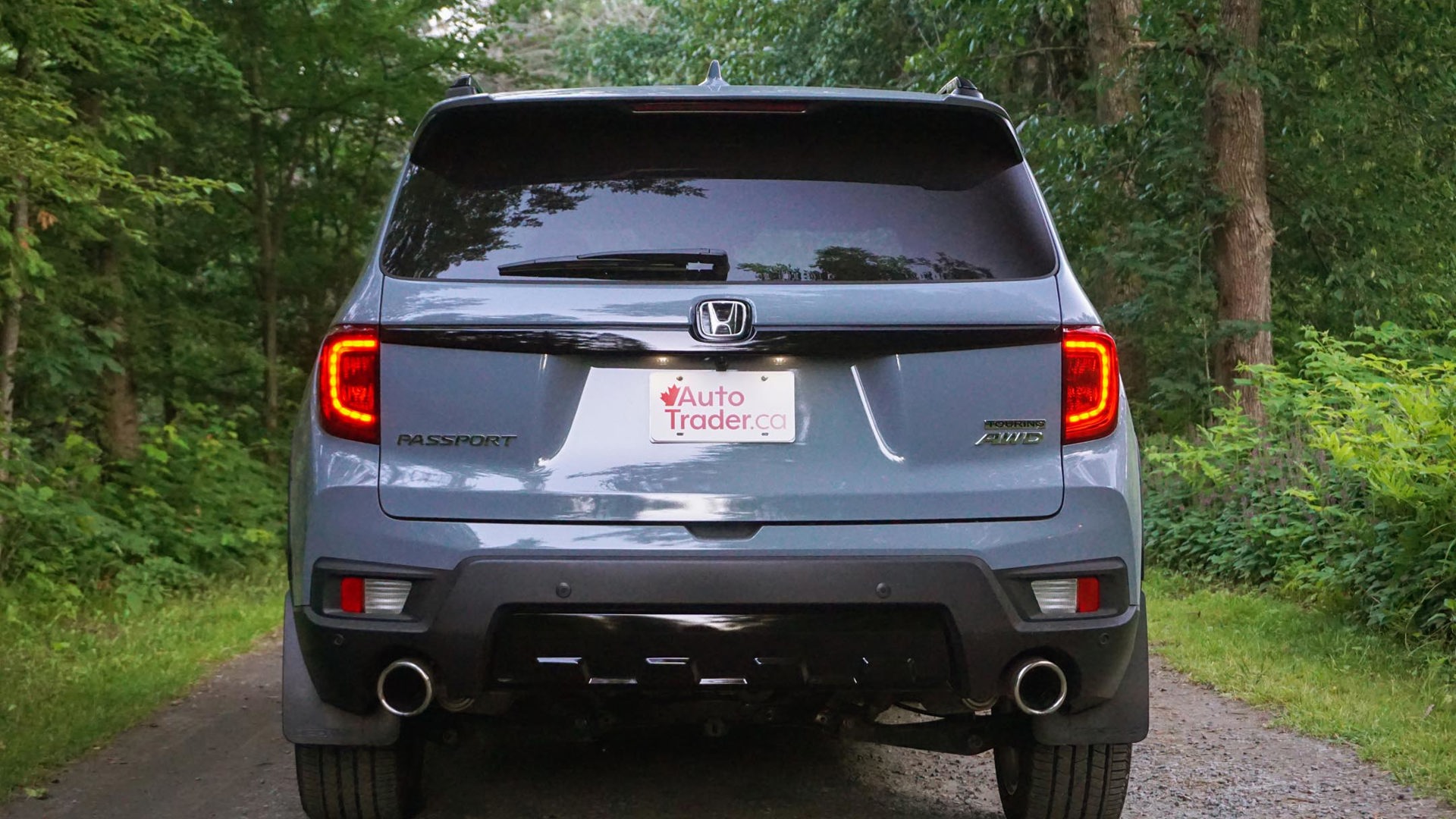 AutoTrader SCORE
AutoTrader SCORE
-
STYLING8/10
-
Safety8/10
-
PRACTICALITY8/10
-
USER-FRIENDLINESS8/10
-
FEATURES9/10
-
POWER9/10
-
COMFORT9/10
-
DRIVING FEEL8/10
-
FUEL ECONOMY7/10
-
VALUE6/10
There isn’t much that the Honda CR-V is bad at – not that it’s perfect, but the popular compact crossover does just about everything that’s asked of it.
It’s not exactly adventurous, though, which is where the 2022 Honda Passport comes in. No, it’s not especially rugged – and it’s fairly expensive – but what it delivers is a sort of “adventure support vehicle” akin to the Ford Bronco Sport, only with more room for people and stuff.
Styling: 8/10
The Passport got a facelift for this year that puts some separation between it and the three-row Honda Pilot on which it’s based. Whether or not it was better before is up for debate, as the rather flat front end is at least a little visibly jarring. So is the $4,900 Honda Performance Development package that was added to this tester, which includes bold body-side graphics and chunky pieces of protection for the wheel arches and rockers, as well as slick gold wheels. It’s probably not for everyone, but then it plays up the adventurous vibe Honda was going for.
The cabin is more typical of the brand’s offerings in that it’s all a little visually underwhelming, even in this range-topping Touring trim. It’s not unattractive, but there isn’t much to fawn over, either. Black plastic surfaces of varying quality adorn the dash and doors, while the seats are upholstered in black leather. For those looking for at least a splash of colour, the new-for-2022 TrailSport trim has some orange stitching and embroidery, but that’s about it.
Practicality: 8.5/10
Rather than being conventionally stylish the cabin is centred around practicality, with tiered door panels up front and a pair of cupholders on each in the back. A retractable cover opens to reveal a deep bin between the front seats, while both feature armrests to make up for how low the console itself sits.
Occupant space is abundant front and back, although the rear doors don’t open especially wide the way they do on the sibling CR-V, which makes climbing inside a little awkward for adults. Likewise, the Passport’s power tailgate – which can be opened with the kick of a foot on this Touring trim – isn’t height-programmable like the CR-V’s, which could pose a problem for those who park indoors.
But that’s where the complaints end, with outstanding cargo room and easy configurability of the space. The liftover height is perhaps a little high, but the 1,430 L behind the back seats is cavernous. The 60/40 split-folding bench can be slid forward for a bit more room, while each side can be stowed using levers on the seats themselves or with buttons in the back. Dropping them both opens up 2,852 L in total, while a compartment under the load floor provides some out-of-sight storage.
Features: 9/10
Deserving of a special mention is the optional Advanced Protection kit ($981) that includes not just a fitted cargo mat but matching ones for the rear seatbacks and wheel housings. It all proved useful during a camping trip where firewood was stacked in the back of the Passport – alongside a whole host of gear, of course – without leaving splinters or shavings embedded in the carpet.
Some thoughtful stuff is found across the lineup, including roof rails – plus steps inside the back doors designed to make accessing cargo up top easier – and walk-away door locks, plus proximity sensors on the front door handles for fob-free access. Tri-zone automatic climate with dedicated controls in the back, heated front seats and steering wheel, a sunroof (not a panoramic one, though), and Apple CarPlay and Android Auto connections are all standard, too.
Moving to the TrailSport trim adds stuff like heated rear seats, a household power outlet, memory settings for the driver’s seat, a wireless phone charger, and satellite radio, while the range-topping Touring adds ventilated front seats, built-in navigation, a built-in Wi-Fi hotspot, and a 10-speaker stereo.
Power: 9/10
It’s not just that the Passport is slightly larger than the CR-V, but it also employs a bigger engine. Borrowed from its platform-mate Pilot (as well as the Ridgeline pickup and Odyssey minivan), the 3.5L V6 enables maximum towing of 2,268 kg (5,000 lb) when fitted with the package that includes a transmission fluid cooler; otherwise, capacity is capped at 1,588 kg (3,500 lb).
With a nine-speed automatic transmission channelling output to all four wheels, the 3.5L feels strong though not overly powerful. With 280 hp and 262 lb-ft of torque, it’s on par with the likes of the Toyota 4Runner – a sport utility that can be outfitted for adventure right from the factory. Being naturally aspirated means the six-cylinder builds torque progressively, and it even sounds good, too.
Driving Feel: 8/10
Like most modern systems, the all-wheel drive unit used here is of the fully automatic variety and stops sending output rearward until it’s needed. That means most cruising is done with only the front wheels connected to the engine, although as much as 70 per cent of the available torque can be sent to the back wheels as required. There are also terrain modes that tailor the drivetrain for conditions like sand and snow, locking torque distribution to all four wheels in the process.
Steering feel is virtually non-existent, with little sense of which way the wheels are pointed, although responsiveness is more than adequate. All told, the Passport is fairly agile in spite of its moderate 205 mm (8.1 in) of ground clearance and overall height of 1,835 mm (72.2 in).
Fuel Economy: 6/10
With eco mode engaged, throttle response is noticeably relaxed, but it also leads to efficiency gains next to the Passport’s official numbers. According to Natural Resources Canada (NRCan), this Honda is good for 11.3 L/100 km combined – about the same as a V6-powered Jeep Grand Cherokee and better than the aforementioned 4Runner. More crucially, it’s quite a bit worse on gas than the Mazda CX-50 and its turbocharged engine that’s similar in its off-road lite execution.
With the all-wheel drive system frequently decoupled and eco mode engaged, the Passport overachieved during testing, registering 10.2 L/100 km over the course of approximately 780 km of driving. It should be noted that the vast majority of that mileage was racked up on the highway heading to and from a long-weekend camping trip.
User Friendliness: 8/10
Packing (and unpacking) for that trip was perhaps the best showcase for how spacious this sport utility is, the wide tailgate opening making it easy to load and reconfigure cargo on the fly. While a height-programmable hatch would’ve made the process easier for this apartment-dwelling author, the Passport proved itself to be a model of functionality otherwise.
The controls up front aren’t entirely in keeping with that principle of simplicity, but it’s not all bad, either. The buttons and rockers for the climate system, for instance, are as simple as they come, but the infotainment system could use some work. Granted, it all worked, which hasn’t always been the case, but the eight-inch touchscreen manages to look and feel smaller than it is, while the system itself isn’t quick in its response to inputs. There’s also the button-based gear selector on the console that’s a little clunky and awkward to use.
Safety: 8/10
More physical controls are found on the steering wheel, including ones for the adaptive cruise and lane-keep assist systems that are standard. The former keeps a fairly large distance from preceding traffic, while it often struggles to maintain its prescribed speed uphill – even on shallow inclines.
The rest of Honda’s advanced safety suite is standard, with blind-spot monitoring and rear cross-traffic alert, automatic high-beam control, lane departure warning, a rear-seat reminder, and forward collision warning with automatic emergency braking. Like adaptive cruise control, the forward collision warning system seems a little on the precautious side, beeping and flashing unnecessarily in stop-and-go traffic in spite of keeping a safe, comfortable distance.
Comfort: 9/10
A little gridlock traffic – OK, a lot of it – is common on Highway 400 that runs north of Toronto and beyond. So it wasn’t exactly surprising to encounter some of it on the roughly 230-km journey to Oastler Lake Provincial Park just outside Parry Sound, Ont. Graciously, the front seats proved comfortable the whole way, while ride quality was perhaps a little short of exemplary but impressive overall. Acoustically insulated glass and active noise cancellation helped keep outside interference to a minimum, meanwhile.
Value: 6/10
Where the Passport encounters its biggest issue is how much Honda is charging for it. Take its starting price of $47,520 (including a non-negotiable freight charge of $1,950); that’s about the same as the most expensive Mazda CX-50 out there, which is probably the Passport’s closest rival despite being slightly smaller. Likewise, even a decked out Subaru Outback is about $3,000 less than the Passport’s starting price, while the rugged-for-real Wilderness version is cheaper still.
The mid-grade TrailSport trim starts at $51,220, while the range-topping Touring kicks off at $54,120. Meanwhile, the options added to this tester – namely the expensive Honda Performance Development styling kit – pushed the asking price to just over $60,000 before tax. The same kind of money could at least gain entry to the far more modern Jeep Grand Cherokee lineup (although there are plenty of trims that cost more).
The Verdict
The Honda Passport is part of a trendy crop of semi-rugged SUVs, and it’s a fairly well executed example of exactly that. Aside from a few miscues like the tailgate, it’s a competitive product with plenty of room. The trouble is that it’s probably a good $5,000 overpriced – especially next to a competitor like the Mazda CX-50 and Subaru Outback. It’s not that the Passport isn’t worthy of consideration in this segment, but so are its rivals – some of which deliver more for less.
| Engine Displacement | 3.5L |
|---|---|
| Engine Cylinders | V6 |
| Peak Horsepower | 280 hp @ 6,000 rpm |
| Peak Torque | 262 lb-ft @ 4,700 rpm |
| Fuel Economy | 12.5 / 9.8 / 11.3 L/100 km cty/hwy/cmb |
| Cargo Space | 1,430 / 2,852 L seats up/down |
| Model Tested | 2022 Honda Passport Touring |
| Base Price | $52,170 |
| A/C Tax | $100 |
| Destination Fee | $1,950 |
| Price as Tested | $60,401 |
|
Optional Equipment
$6,181 – HPD Package, $4,900; Advanced Protection Package, $981; Sonic Grey Pearl Paint, $300
|
|












































